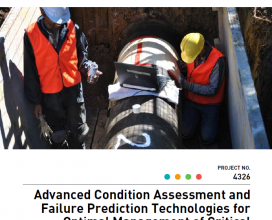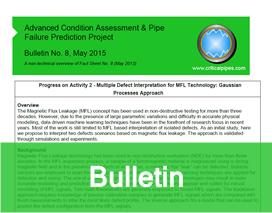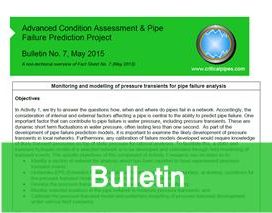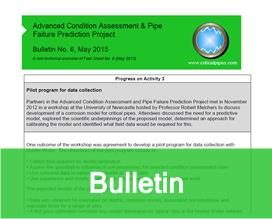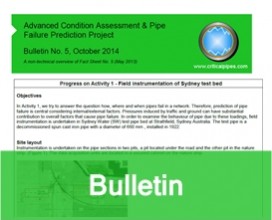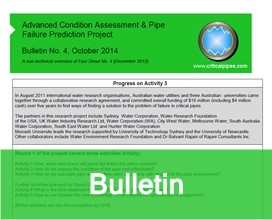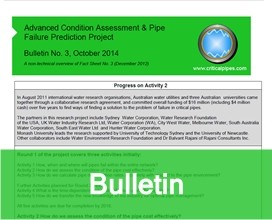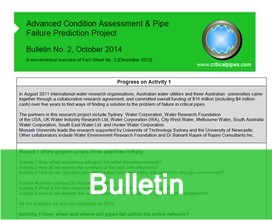The Bulletins shown on this page are reworked versions of Fact Sheets available on the Fact Sheets page. The purpose of a specific Bulletin is to communicate the essence of a corresponding Fact Sheet but with technical complexities edited out, thus making it easier to read for those who do not have the relevant technical knowledge.
 Advanced Condition Assessment and Failure Prediction Technologies for Optimal Management of Critical Water Supply Pipes
Advanced Condition Assessment and Failure Prediction Technologies for Optimal Management of Critical Water Supply Pipes
KEY FINDINGS A new Excel-based pipe stress prediction tool (“Monash Tool”) was developed for large-diameter cast iron (CI) water pipes. A leak-before-break (LBB) concept was proposed for pipe failure prevention. Managing internal pressure may extend CI pipe life. Corrosion does not progress as a linear function from its origin. Therefore, a corrosion “rate” is highly…
 Bulletin No. 8 Progress on Activity 2 – Multiple defect interpretation for MFL technology: Gaussian processes approach
Bulletin No. 8 Progress on Activity 2 – Multiple defect interpretation for MFL technology: Gaussian processes approach
The Magnetic Flux Leakage (MFL) concept has been used in non-destructive testing for more than three decades. However, due to the presence of large parametric variations and difficulty in accurate physical modelling, data driven machine learning techniques have been in the forefront of research focus in recent years. Most of the work is still limited…
 Bulletin No.7 Monitoring and modelling of pressure transients for pipe failure analysis
Bulletin No.7 Monitoring and modelling of pressure transients for pipe failure analysis
In Activity 1, we try to answer the questions how, when and where do pipes fail in a network. Accordingly, the consideration of internal and external factors affecting a pipe is central to the ability to predict pipe failure. One important factor that can contribute to pipe failure is water pressure, including pressure transients. These are dynamic short…
 Bulletin No.6 Progress on Activity 3 – Pilot program for data collection
Bulletin No.6 Progress on Activity 3 – Pilot program for data collection
Partners in the Advanced Condition Assessment and Pipe Failure Prediction Project met in November 2012 in a workshop at the University of Newcastle hosted by Professor Robert Melchers to discuss development of a corrosion model for critical pipes. Attendees discussed the need for a predictive model, explored the scientific underpinnings of the proposed model, determined an approach for calibrating…
 Bulletin No.5 Progress on Activity 1 – Field instrumentation of Sydney test bed
Bulletin No.5 Progress on Activity 1 – Field instrumentation of Sydney test bed
In Activity 1, we try to answer the question how, where and when pipes fail in a network. Therefore, prediction of pipe failure is central considering internal/external factors. Pressures induced by traffic and ground can have substantial contribution to overall factors that cause pipe failure. In order to examine the behaviour of pipe due to these loadings,…
 Bulletin No.4 Progress on Activity 3
Bulletin No.4 Progress on Activity 3
In August 2011 international water research organisations, Australian water utilities and three Australian universities came together through a collaborative research agreement, and committed overall funding of $16 million (including $4 million cash) over five years to find ways of finding a solution to the problem of failure in critical pipes. The partners in this research…
 Bulletin No.3 Progress on Activity 2
Bulletin No.3 Progress on Activity 2
In August 2011 international water research organisations, Australian water utilities and three Australian universities came together through a collaborative research agreement, and committed overall funding of $16 million (including $4 million cash) over five years to find ways of finding a solution to the problem of failure in critical pipes. The partners in this research…
 Bulletin No.2 Progress on Activity 1
Bulletin No.2 Progress on Activity 1
In August 2011 international water research organisations, Australian water utilities and three Australian universities came together through a collaborative research agreement, and committed overall funding of $16 million (including $4 million cash) over five years to find ways of finding a solution to the problem of failure in critical pipes. The partners in this research…

